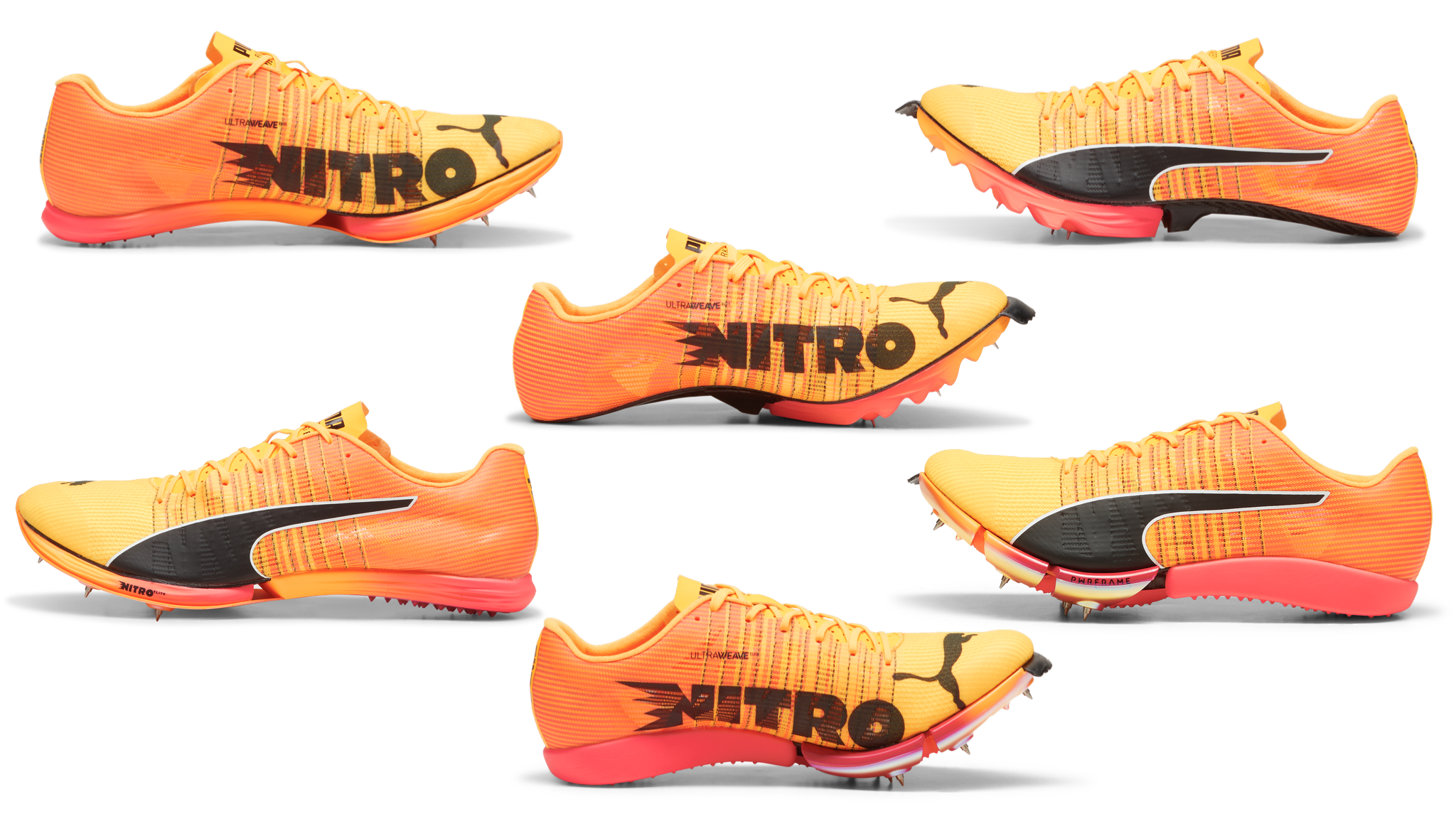What Are Track Super Spikes?

As athletes at the Olympic Games raised their hands in success or despair, we found ourselves looking at their feet.
Most of us at The Running Channel are more familiar with wearing nice comfy road shoes, or occasionally slipping on carbon plate shoes to run fast, so the colourful and slimline track shoes stood out on Paris’s purple track.
We wanted to find out more about track spikes, and about how a new generation of ‘super spikes’ are transforming athletic performance.
What Are ‘Super Spikes’ And How Are They Different To Regular Spikes?
Specific running spikes evolved around 100 years ago, gaining popularity at the Paris 1924 Olympic Games, where the slim leather shoes with spikes, or pins, in a firm sole helped with traction on the cinder surface. The shoes were lightweight to enable faster running, but they weren’t known to be comfortable or supportive.
Over the decades, track shoes have kept their slimline profile and a standard design: a firm spike plate in the base which the pins are screwed into, a small amount of midsole foam for comfort, and a light upper. But as shoe technology has changed with the introduction of premium performance foams and materials, so track spikes have also evolved.
Super spikes include a performance plate above the functional spike plate, and the lightweight foams have been optimised for maximum responsiveness and performance for athletes, improving their energy return with each stride. And researchers have realised that different athletes have requirements from their spikes.
Super Spikes Versus Super Shoes?
As runners more familiar with carbon plate racing shoes, so how do they compare to these plated track spikes?
“The ingredients are the same for both shoes and you have a plate, a super foam, and a rocker geometry,” says Laura Healey, Senior Manager of Research and Sports Science, Footwear Innovation for PUMA, “but we’re tuning the recipe for different events,” she says.
“For road running we’re optimising for efficiency,” but for track and field, and sprinting more specifically, “we’re optimising for force production,” says Laura.
There are also rules to follow. World Athletics has decided that road shoes can have a maximum stack height of 40mm foam to be competition legal for elite runners (there are max-stack shoes with over 40mm foam, but they are not eligible for elites in races – they are fine for non-elites to wear, if we wish).
Track shoes can currently have a maximum foam height of 25mm, and as of November 2024 that’s dropping to 20mm.
World Athletic rules also state that spikes and shoes worn by athletes must also be commercially available, so they cannot be custom made for a runner or jumper.
Beyond that “track spikes get more niche than a regular running shoe,” says Jose Van der Veen, Global Head of Product Line Management Track & Field at PUMA.
Think about a 100m sprint, a 10,000m run, and a high jump. Each event has different amounts of force and power required, meaning slightly different designs to the spikes.
Finding The Right Super Spike
Super spikes have been used for around five years, and even at the Tokyo Olympics, held in 2021, there were only a small variety available. Three years later, and a lot has changed.
In Tokyo, PUMA had two different super spikes for their athletes, but in Paris they had six super sprint spikes, two distance spikes, three jump spikes, plus two carbon plate road shoes. “Our arsenal is expanding,” says Jose.
All the super spikes feature PUMA’s nitrogen-infused foam which has been designed by PUMA’s own in-house chemists to provide the most responsiveness and energy return, using different densities of foam based on the requirements of the athletes. The shoes all also have a carbon fibre plate, with its shape changing based on the type of event. Using Laura’s analogy, while the ingredients are the same, the recipes change.
Jump spikes are the stiffest. They have the hardest plate to manage the great force of the jump takeoff, and the foam density is the firmest (in case you’re wondering, the take-off shoe of a jumper is the same as the non-take off shoe).
Distance spikes, which work for 800m upwards, have a less rigid plate, plus more foam which gives more cushioning and energy return over the longer events, while still being as responsive as possible.
Sprint spikes are in the middle, with less foam and the firm plate for maximum power.
“If a 100m runner wore a long distance spike it probably wouldn’t feel responsive to them because of the forces and the speed that they put into the shoe,” says Laura. “Similarly if a long distance runner was trying to run a 5km in a sprint spike, it would probably feel super hard, because the forces aren’t the same.”
These differences and developments have come from working with numerous athletes in their varied disciplines.
“We’re playing with the exact stiffness, the plate geometry, the responsive of the foam, and how we can make the perfect package there,” says Laura. And it’s allowed them to develop spikes for different types of athletes, because not every sprinter sprints the same.
“You have a power sprinter, you have an elastic sprinter; you have a more powerful jumper, the more technical jumper,” says Jose, so they are building specific spikes for specific types of athletes within these events.
The power sprinter takes fewer steps over a 100m, hitting the ground with greater force on each stride. Think about Usain Bolt, who is tall and powerful, compared to an elastic sprinter like Andre de Grasse who is shorter and has more leg turnover during a race.
That research has also gone into road super shoes and at the Paris Olympic Marathon, PUMA athletes could choose between two different carbon plate shoes to run in: Fast-R Nitro Elite 2 and the Deviate Nitro Elite 3. We’re beginning to see the running shoe market create new shoes based on individual running styles, including other examples like ASICS and their Metaspeed Sky and Edge.
The Future Of Super Spikes
“I think what we have now is amazing,” says Laura, “but I like to think that we still have a long way to go – it’s going to be a never ending evolution. The compounds are going to forever be improving, so we’re getting better materials and understanding how they work together, and how they influence the athlete,” she says. “The jump in the past few years has been dramatic.”
Jose adds: “It’s an arms race to get better and better in the foam compounds and in the responsiveness.”
Just like in road super shoes, technology and research are enabling shoe companies to continually innovate and improve, which should be exciting for runners – whether we wear them ourselves, or just enjoy watching elites perform at their best when wearing them.




























Running News
Ingebrigtsen Stars at World Athletics Indoor Championships 2025 – Plus All The Winners!
Sam Ruthe Is First 15-Year-Old To Run A Four-Minute Mile!
Eliud Kipchoge Will Run The 2025 Sydney Marathon!